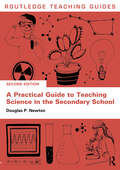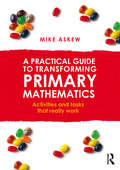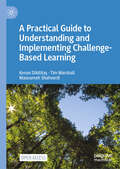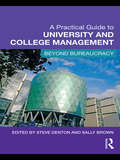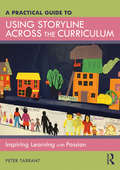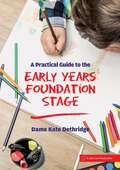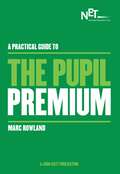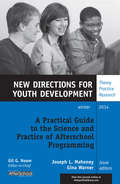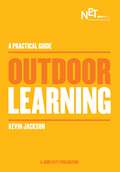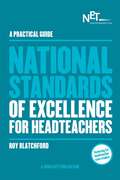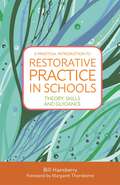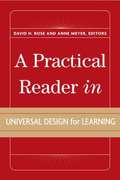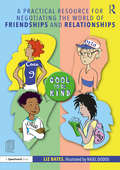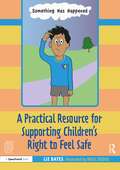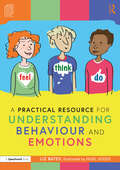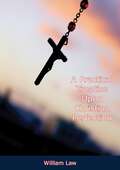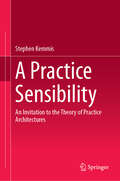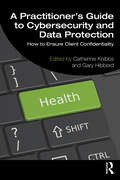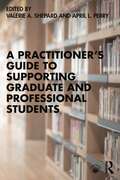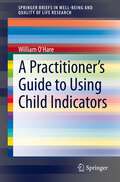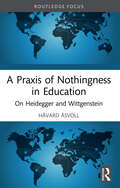- Table View
- List View
A Practical Guide to Teaching Science in the Secondary School (Routledge Teaching Guides)
by Douglas P. NewtonA Practical Guide to Teaching Science in the Secondary School is designed to support student teachers as they develop their teaching skills and increase their broader knowledge and understanding for teaching science. It offers straightforward advice and inspiration on key topics such as planning, assessment, practical work, the science classroom, and on to the broader aspects of teaching science. This thoroughly updated second edition reflects on new expectations, requirements, and practices in science teaching, with chapters exploring key and contemporary topics such as: The nature of science and scientific argument The various kinds of thinking emphasised in science and how to exercise them How to engage students in learning Assessment for and of learning Diverse needs and how to meet them The use of technology to support teaching and learning Learning at a distance. Designed to be used independently or alongside the popular textbook Learning to Teach Science in the Secondary School, this book is packed with revised and updated case studies, examples of pupils' work, and resources and activities in every chapter. It provides everything trainee and early career teachers need to reflect on and develop their teaching practice, helping them to plan lessons across the subject in a variety of teaching situations.
A Practical Guide to Transforming Primary Mathematics: Activities and tasks that really work
by Mike AskewA Practical Guide to Transforming Primary Mathematics offers inspiration and ideas for all training and practising teachers committed to making mathematics enjoyable, inclusive, engaging and successful. The companion to Mike Askew’s bestselling book, Transforming Primary Mathematics, this practical guide focuses on showing you how to unlock the powerful potential of a small set of consistent principles and practices, known as the teaching tripod, to develop a coherent approach to teaching mathematics. Organised around the major strands of the curriculum - number, calculations, shape and space, measures, and data handling – it offers an accessible introduction to the teaching tripod, a careful choice of tasks, supported by a range of tools that extend our natural abilities and held together by careful attention to classroom talk. A range of classroom tasks, each including key learning outcomes, clear links to the framework, links to relevant research, and suggestions for making the tasks easier or harder, are offered for every topic, helping you plan units of work for meaningful learning. A Practical Guide to Transforming Primary Mathematics offers all teachers a vision, rationale and ideas for how teaching can support better learning of mathematics but also encourage learners to see themselves as being capable of learning mathematics, and wanting to learn it.
A Practical Guide to Understanding and Implementing Challenge-Based Learning
by Tim Marshall Kenan Dikilitaş Masoumeh ShahverdiThis open access book maps the role of challenge-based learning (CBL) in the transformation of higher education pedagogy, towards being sector-informed as well as student-driven. CBL democratises the process of learning by repositioning students as drivers, who are empowered to make decisions on course content, assess needs in the real world and develop opinions. Teachers monitor student learning and engagement and mentor students to express their needs. Chapters showcase existing CBL practices in different settings, and include case studies which detail the practical application of CBL in multiple contexts. The authors develop an emerging theory of practical learning based on the insights of the curriculum designers, practitioners and students. The book will be of interest to researchers, teacher educators/trainers and research supervisors in higher education.
A Practical Guide to University and College Management: Beyond Bureaucracy
by Sally Brown Steve DentonWritten for Higher Education managers and administrators, A Practical Guide to University and College Management is a highly accessible text that offers practical guidance on how to manage the day-to-day life of universities. The authors take a proactive approach and offer a range of good practice examples and solutions, designed to resolve the dilemmas that arise in today’s rapidly changing higher education environment. Drawing on a wealth of management experience, this edited collection pulls together advice and practical guidance from expert managers working in the field of Higher Education. Each chapter is underpinned by theoretical perspectives to support invaluable pragmatic hints, mini-case studies, practical examples, and sample guidelines. The book covers four main areas: Selecting and inducting students: This section outlines the essential process for targeting, attracting, recruiting and inducting students Managing throughout the university year: Advice on the student experience, from the admissions process right up to graduation Assuring the quality of the student learning experience: How to manage course administration, student learning through assessment, student complaints and issues of quality assurance Maximising staff and student engagement: This section looks at how to maximise commitment and involvement by both staff and students, and includes approaches and examples of engagement implementation at other universities A Practical Guide to College and University Management will be of interest to Higher Education managers, administrators, and anyone looking for a pragmatic "how to" navigational guide that informs the working life of a university, from attracting students through to graduation. It offers managers and administrators essential training and support required to promote highly successful and efficient Higher Education Institutions, and is essential reading for anyone who works in university administration or aspires to do so. Sally Brown is Pro-Vice-Chancellor for Assessment, Learning and Teaching at Leeds Metropolitan University. She has published widely on innovations in teaching, learning and particularly assessment. Steve Denton is Pro-Vice-Chancellor and Registrar and Secretary at Leeds Metropolitan University bringing together University-wide student administrative and support services, including governance and legal matters, the academic registry, planning, student services, communication and marketing and widening access and participation.
A Practical Guide to Using Storyline Across the Curriculum: Inspiring Learning with Passion
by Peter TarrantA Practical Guide to Using Storyline Across the Curriculum provides a comprehensive introduction to the Storyline approach to teaching and learning – an approach that embraces and encourages children’s passion for learning. Putting children at the centre of learning, the book explores how educators and teachers can harness pupils’ innate appetite for stories to make interdisciplinary teaching and learning enjoyable and successful. Demonstrating how teachers can easily use the Storyline approach within the curriculum, this book offers a step-by-step introduction to learning developed through the use of narrative. Key topics explained include: planning individual lessons and sequences of lessons; guidance on planning and progress; assessment and evaluation of learning; links with visible learning and growth mindset approaches. Filled with detailed examples of storylines that have been tried and tested in the classroom, A Practical Guide to Using Storyline Across the Curriculum offers new and experienced teachers an accessible guide to the Storyline approach, with ready-to-use ideas to enable, inspire and support learners.
A Practical Guide to the Early Years Foundation Stage
by Kate Dethridge'A Practical Guide to Early Years Education' has been written in order to support colleagues in gaining an understanding of what excellent provision looks like and offers tools and resources to help you manage, improve and sustain high quality provision in your setting. Pick up a book about Early Years education and too often it is heavily weighted to research and theory. These are important of course, but for many of us who are busy and time poor, we want to be able to open a book and find it full of good ideas and easily accessible resources, easy to read and written by someone who does the job day in and day out. Whether you are a child minder, work in a nursery or in a school, this book will offer you sensible, practical advice about what you can do to improve the experience for the children in your care, meet their individual needs and sustain improved learning outcomes.Written in a clear and easily accessible way, each chapter focuses on a key area of provision and offers a wealth of practical ideas and resources to help you: *Understand what excellent provision looks like and should include * Audit your own provision and identify strengths and areas to improve * Develop resources and guidance for staff to ensure that your setting offers all the necessary support and skills to ensure the children in your care are stimulated, develop excellent attitudes to learning and make progress.
A Practical Guide to the Early Years Foundation Stage
by Kate Dethridge'A Practical Guide to Early Years Education' has been written in order to support colleagues in gaining an understanding of what excellent provision looks like and offers tools and resources to help you manage, improve and sustain high quality provision in your setting. Pick up a book about Early Years education and too often it is heavily weighted to research and theory. These are important of course, but for many of us who are busy and time poor, we want to be able to open a book and find it full of good ideas and easily accessible resources, easy to read and written by someone who does the job day in and day out. Whether you are a child minder, work in a nursery or in a school, this book will offer you sensible, practical advice about what you can do to improve the experience for the children in your care, meet their individual needs and sustain improved learning outcomes.Written in a clear and easily accessible way, each chapter focuses on a key area of provision and offers a wealth of practical ideas and resources to help you: *Understand what excellent provision looks like and should include * Audit your own provision and identify strengths and areas to improve * Develop resources and guidance for staff to ensure that your setting offers all the necessary support and skills to ensure the children in your care are stimulated, develop excellent attitudes to learning and make progress.
A Practical Guide to the Pupil Premium
by Marc RowlandPublished in partnership with the National Education Trust, this book provides essential information and advice to help schools make best use of the Pupil Premium grant and improve outcomes for disadvantaged learners. The author visited more than 100 schools over two years and here he shares examples of innovation and excellence in their use of the additional funding. The book includes official Government directives on the Pupil Premium, which was introduced in 2011 to narrow the attainment gap between disadvantaged learners and their more affluent peers.
A Practical Guide to the Pupil Premium
by Marc RowlandPublished in partnership with the National Education Trust, this book provides essential information and advice to help schools make best use of the Pupil Premium grant and improve outcomes for disadvantaged learners. The author visited more than 100 schools over two years and here he shares examples of innovation and excellence in their use of the additional funding. The book includes official Government directives on the Pupil Premium, which was introduced in 2011 to narrow the attainment gap between disadvantaged learners and their more affluent peers.
A Practical Guide to the Science and Practice of Afterschool Programming: New Directions for Youth Development, Number 144 (J-B MHS Single Issue Mental Health Services)
by Joseph L. Mahoney Gina WarnerClosing the gap between scientific research on afterschool programming and the practices occurring in these settings is the goal of this volume. Both sources of knowledge are critical to developing the afterschool workforce’s ability to provide high-quality programming. On the one hand, this means afterschool staff should not work with young people until they have been adequately prepared—which includes training in evidence-based practices—and properly supervised. On the other hand, it requires that scientists understand and study those aspects of afterschool programming most relevant to the needs of practitioners. This volume includes perspectives from the afterschool workforce, scientists who discuss the current research, and the practitioners who know how afterschool programs operate in practice. This is the 144th volume of New Directions for Youth Development, the Jossey-Bass quarterly report series dedicated to bringing together everyone concerned with helping young people, including scholars, practitioners, and people from different disciplines and professions.
A Practical Guide: A Practical Guide
by Kevin JacksonAn informative, practical and authoritative guide that makes the argument for undertaking outdoor and adventurous learning - and offers advice for how to organise trips to enable students and teachers to get the most from them. Inspiring enthusiasm for real learning and growing, it provides opportunities for children, young people and their teachers to seek memorable experiences and develop life-long interests.
A Practical Guide: A Practical Guide
by Kevin JacksonAn informative, practical and authoritative guide that makes the argument for undertaking outdoor and adventurous learning - and offers advice for how to organise trips to enable students and teachers to get the most from them. Inspiring enthusiasm for real learning and growing, it provides opportunities for children, young people and their teachers to seek memorable experiences and develop life-long interests.
A Practical Guide: The National Standards of Excellence for Headteachers
by Roy BlatchfordThis Practical Guide seeks to illuminate the National Standards of Excellence for Headteachers, presenting a range of perspectives to bring the text alive for current and future school leaders and for those with the vital responsibilities of proper governance. Part Two of the book comprises the official Standards published by the DfE, by way of handy reference.
A Practical Guide: The National Standards of Excellence for Headteachers
by Roy BlatchfordThis Practical Guide seeks to illuminate the National Standards of Excellence for Headteachers, presenting a range of perspectives to bring the text alive for current and future school leaders and for those with the vital responsibilities of proper governance. Part Two of the book comprises the official Standards published by the DfE, by way of handy reference.
A Practical Introduction to Restorative Practice in Schools: Theory, Skills and Guidance
by Margaret Thorsborne Bill HansberryProven to reduce bad behaviour and exclusions, and encourage happier, safer school environments, restorative justice is an effective approach to conflict resolution. Suitable for education settings from preschool to college, this guide explains what restorative justice is, how it can be used in schools, what it looks like in the classroom and how it can be implemented. Featuring case studies that illuminate the underlying restorative principles and practices, this book covers a wide range of topics from the basics of restorative justice, through to school-wide processes for embedding the approach in policy and practice. Drawing on the expertise of educators and consultants, this is a must-have resource for any school or centre that is serious about reducing bad behaviour and developing safer learning communities.
A Practical Reader in Universal Design for Learning
by Anne Meyer David H. RoseUniversal Design for Learning (UDL) stands at the forefront of contemporary efforts to create universal access to educational curricula for all students, including those with disabilities. The universal in UDL does not mean there is a single optimal solution for everyone.
A Practical Resource for Negotiating the World of Friendships and Relationships
by Liz BatesThis is a practical resource for use by teachers, support staff and therapists that contains session ideas for use with children to promote kindness, friendship and self-compassion. It includes detailed lesson plans with extensive guidance and photocopiable activity sheets to support individuals, groups or classes of children aged 7 and upwards. This guidebook can be used to: Help children understand the value of kindness, both to themselves and to others Nurture the moral development of children Support children who may be struggling with self-worth and self-kindness This guidebook is available to purchase as part of a two-component set, Negotiating the World of Friendships and Relationships: A ‘Cool to be Kind’ Storybook and Practical Resource. It can be used by teachers, support staff and therapists to teach and promote kindness.
A Practical Resource for Supporting Children’s Right to Feel Safe
by Liz BatesFor effective use, this book should be purchased alongside the storybook. Both books can be purchased together as a set, Something Has Happened: A Storybook and Guide for Safeguarding and Supporting Children’s Right to Feel Safe [978-1-032-06912-8] This programme of activities, created to be used alongside the storybook, Something Has Happened, has been designed to help children develop their own internal measure of safety, and teaches them how to ask for help if they feel unsafe. The sessions and activities in this book directly correlate to episodes in the storybook Something Has Happened, covering the fundamental aspects of safeguarding as well as elements of the Protective Behaviours (PB) process. Taking adults and children through a wide range of discussion points and activities, all underpinned by clear guidance, it acts as a starting point to help children understand that being safe from harm is the most important right they have and that the trusted adults around them will always take action to believe and protect them. Key features of this resource include: Session plans that directly link to events in the Something Has Happened storybook Clear, detailed and accessible activity plans that can be used with whole classes, small groups or with individual children Photocopiable activity sheets With a concise and accessible introduction to the right to feel safe and Protective Behaviours, this is an invaluable resource for teachers, support staff and other professionals working with both primary and lower-secondary aged children.
A Practical Resource for Understanding Behaviour and Emotions (Feel, Think Do with Ruby, Rafa and Riz: A Storybook and Guide for Understanding Behaviour and Emotions)
by Liz BatesFor effective use, this book should be purchased alongside the storybook. Both books can be purchased together as a set, Feel, Think and Do with Ruby, Rafa and Riz: A Storybook and Guide for Understanding Behaviour and Emotions, 978-1-032-05939-6.Written as the adult accompaniment to the Feel, Think and Do with Ruby, Rafa and Riz storybook, this resource explores behaviour with strategies for supporting children who struggle to manage their responses and behaviours; and the role of the adult in recognising signs, de-escalation, connection and reflection. Designed to assist adults in introducing children to their inner world and connecting that world to the world around us in an emotionally safe space, this guidebook contains six sessions that can be delivered to children in a large group, as a class, in smaller groups or individually. These sessions provide the context and landscape of the emotional health of children and what can affect their wellbeing, such as: risk factors and protective factors principles – emotional intelligence, emotional regulation emotions and learning creating emotionally safe spaces the imaginary iceberg – our feelings and thoughts are hidden; our behaviour is on show. Full of opportunities for children to talk about and discuss both the events in the story and their own feelings, thoughts, opinions and ideas, this book enables teachers, support staff and all those working directly with children to expertly cover topics such as the hidden nature of feelings and thoughts, the fact that behaviour is the bit on show, and how talking about feelings and thoughts can help to explain and understand behaviour.
A Practical Treatise Upon Christian Perfection
by William LawWilliam Law, born in 1686, became a Fellow of Emmanuel College, Cambridge in 1711, but in 1714, at the death of Queen Anne, he became a non-Juror: that is to say, he found himself unable to take the required oath of allegiance to the Hanoverian dynasty (who had replaced the Stuart dynasty) as the lawful rulers of the United Kingdom, and was accordingly ineligible to serve as a university teacher or parish minister. He became for ten years a private tutor in the family of the historian Edward Gibbon (who, despite his generally cynical attitude toward all things Christian, invariably wrote of Law with respect and admiration), and then retired to his native King's Cliffe. Forbidden the use of the pulpit and the lecture-hall, he preached through his books. These include Christian Perfection, the Spirit of Love, the Spirit of Prayer, and, best-known of all, A Serious Call To a Devout and Holy Life, published in 1728.‘Law was about forty years of age when he wrote it and had he written no more, his reputation as a prose writer and ascetic theologian would have been established. The title of the book also Illustrates two dominant traits in his personality, the concern to be practical and the primary importance of growth in holiness. The perfection he recommends ‘calls no one to a cloyster, but to a right and full performance of those duties, which are necessary for all Christians, and common to all states of life'. It is the heart that finds expression in our actions, and it is the heart, therefore, that must be made perfect.' (A. Keith Walker, William Law, p. 47; quotation from Law's Introduction, p. 2)
A Practice Sensibility: An Invitation to the Theory of Practice Architectures
by Stephen KemmisThis book introduces readers to the theory of practice architectures and conveys a way of approaching practice theory through developing a practice sensibility. It shows that, in order to change our practices, we must also change the conditions that make those practices possible. The book draws on everyday life to illustrate how we can see the world by watching it unfold in practices: it argues that life happens in practices. The theory of practice architectures takes the ontological nature of practices seriously by recognising that practices take place in the real world. Consequently, the book offers a new perspective on how practices happen amidst a vast world of happenings; on how we participate in the “happening-ness” of the world through our practices. It invites us to consider whether our practices reproduce or aggravate the contemporary environmental crises confronting the Earth, and whether we can transform our current practices to ameliorate these crises. Given its focus and scope, the book will benefit master’s and doctoral students in social and educational theory, early career researchers, and established researchers new to practice theory.
A Practitioner’s Guide to Cybersecurity and Data Protection: How to Ensure Client Confidentiality
by Catherine Knibbs Gary HibberdA Practitioner’s Guide to Cybersecurity and Data Protection offers an accessible introduction and practical guidance on the crucial topic of cybersecurity for all those working with clients in the fields of psychology, neuropsychology, psychotherapy, and counselling. With expert insights, it provides essential information in an easy-to-understand way to help professionals ensure they are protecting their clients’ data and confidentiality, and protecting themselves and their patients from cyberattacks and information breaches, along with guidance on ethics, data protection, cybersecurity practice, privacy laws, child protection, and the rights and freedoms of the people the practitioners work with. Explaining online law, privacy, and information governance and data protection that goes beyond the GPDR, it covers key topics including: contracts and consent; setting up and managing safe spaces; children's data rights and freedoms; email and web security; and considerations for working with other organisations. Illustrated with examples from peer-reviewed research and practice, and with practical ‘top tips’ to help you implement the advice, this practical guide is a must-read for all working-from-home practitioners in clinical psychology, developmental psychology, neuropsychology, counselling, and hypnotherapy.
A Practitioner’s Guide to Supporting Graduate and Professional Students
by Valerie A. ShepardThis guide helps faculty and student affairs practitioners better serve graduate and professional school students as they navigate what can be an isolating, taxing, and unfamiliar context. Providing actionable strategies, as well as a common language for practitioners to advocate for themselves and for their students, this book is a quick start manual that defines current issues around graduate and professional student development. Drawing together current resources and research around post-baccalaureate student outcomes, this book explores the diverse student needs of graduate and professional students and provides a clear understanding of their social, personal, and psychological development and how to support their success. Case studies showcase specific examples of practice including a holistic development model for graduate training; integrating academic, personal, professional, and career development needs; promising practices for engagement; a diversity, equity, and inclusion approach to access and outcomes; how graduate schools can be important partners to student affairs professionals; and examples of assessment in action. This book provides tools, resources, communication strategies, and actionable theory-to-practice connections for practitioners, professionals, and faculty at all levels who work to support post-baccalaureate student thriving. Appendix available for download online at www.routledge.com/9780367639884 on the tab that is entitled "Support Material."
A Practitioner’s Guide to Using Child Indicators (SpringerBriefs in Well-Being and Quality of Life Research)
by William O'HareThis book focuses on projects using child indicators outside of a research context and provides a user-friendly set of materials to help professionals or organizations start and sustain high-quality child indicator projects. The book is based on the fundamental idea that better data leads to better decisions regarding programs for children. The number of people with experience and expertise in developing child indicator projects is limited in many countries. This initiative provides critical information on the topic in a cost-effective manner, and thereby fills an important niche regarding the use of child indicators. To the extent that it promotes more and better child indicator projects, the book leads to more attention for children and better decision-making regarding public support for children. It is also likely to increase the number of such projects that exist and to improve the quality of such projects. This easy-to-use and practical guide is for all professionals and organizations working with child indicators data.
A Praxis of Nothingness in Education: On Heidegger and Wittgenstein (Routledge International Studies in the Philosophy of Education)
by Håvard ÅsvollThis book puts forward a "theory of Nothing" and shows how a praxis of "Nothing" can offer new possibilities for educational research and practice. Taking inspiration from Heidegger’s and Wittgenstein’s philosophy and with regards to phenomenology and language, the book indicates how nothing can be a condition for an educational technology. The book translates the complex philosophical thinking of Heidegger and Wittgenstein into the realm of education studies, drawing on their perspectives to contribute to an understanding of how nothingness comes into being and how this relates to education. Arguing that nothingness addresses new possibilities for understanding and how we perceive the world and our place in it, the book theorises different aspects that can be included in a theory of Nothing; including indeterminateness, embodiment and how the inexpressible can be made expressible. The book presents vignettes and examples of educational practice and explores how nothing can show up in educational research, theory and practice. Outlining a unique conceptualisation of nothingness in education, the book will be of great interest to academics, researchers and post-graduate students in the field of educational philosophy and educational theory.
